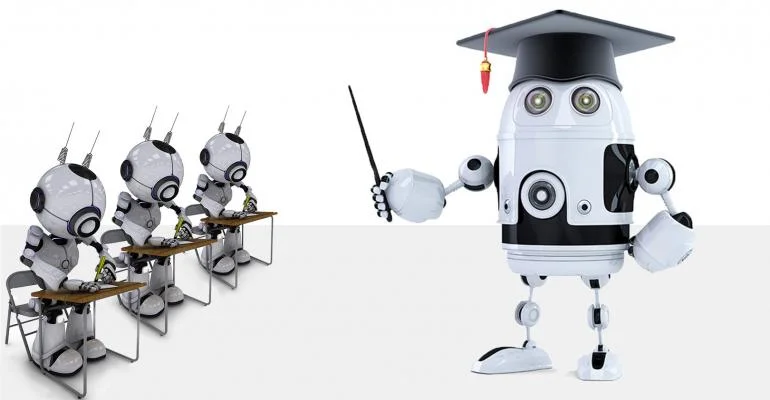Learning to Embrace Intelligent Machines in the New World of Work
While the impacts of machine intelligence (A.I. and machine learning) have been hotly debated, and even provoke anxiety in some, this group of technologies continues to accelerate at a remarkable pace. In fact, according to IDC, global spending on A.I. solutions will continue to see significant corporate investment, achieving revenues of more than $46 billion by 2020. Although machine intelligence offers enormous opportunities for businesses, many struggle to find ways to tap into the technology due to lack of knowledge, limited access to required skill sets, insufficient data, and––to be frank––confusion about where to even begin.
In order to better understand how to both learn with intelligent machines and prepare the next generation to work alongside them, I recently met with top leaders––from Harvard University, Nike Innovation Kitchen, BMW Group, and more––at Autodesk’s Ideas Driving Change summit in San Francisco. The key takeaway was clear: the new relationship between humans and machines is already having far-reaching effects on our societies and economies––and these effects will only become more pervasive as time goes on. We concluded that there has to be a shift from thinking of tools as “things,” to thinking of them as collaborators: active participants in creation—co-creative agents. We are entering an era of tools that teach—and learn. In order to help industry and academia respond to this shift, we identified five ways to better prepare individuals to thrive in the age of intelligent machines.
1. Find Ways to Build Trust Between Human and Machine Teammates
As we begin to look at machines more as teammates than objects, they will inevitably become more embedded in our lives––a fact that admittedly not everyone is ready to embrace. Trust is a key component of any good collaboration, but in order to build trust between humans and machines, companies will have to create policies and invest in systems that encourage co-creation and co-learning. If tools, products, spaces, and experiences have machine intelligence embedded in them, we should look for ways to build virtuous and ethical cycles of learning between the company, the things it produces, and the people who use them. Learning reciprocity between machines and humans, supported by maximum transparency about how the system works, becomes a key component of success.
2. Education Changes in the World of Machine Intelligence
By harnessing machine intelligence, we can help employees and students learn what they need to know, when they need to know it, in the ways that are best suited for them. AI offers the extraordinary promise of helping each of us co-create custom learning pathways in school and beyond. But subjects taught in legacy school settings also need updating. Working with machine intelligence requires skilled problem framing, not just problem solving. Problem framing relies on systems thinking to understand the dynamic, interdependent nature of problems. It is critical to introduce courses and active learning projects to define and teach this core competency. Since complex problems are often solved with many intelligences (human and machine), universities must overcome the dated industrial age bias against teaching the so-called “soft skills” of teamwork and collaboration. Educational institutions should consider partnering with outside businesses to provide students with an understanding of systems thinking and applied machine intelligence “on the job.” Meanwhile, companies should consider academic partnerships that bring the rich work on machine intelligence at universities inside their businesses.
3. Interlocking Challenges: Practice Building and Mining Possibility Spaces
Tools fueled by machine intelligence often require us to think very differently about solving design problems. Instead of thinking about the tool as a blunt instrument to realize our preconceived design intentions, we first need to frame the system constraints, variables, goals, and intersection points. Then the system co-creates with us a “solution space” of design possibilities to choose from and iterate. This framework, more commonly known as generative design, is a powerful way of learning about the new ways of collaborating between humans and machines. Businesses can tap into this by investing in a set of pilot projects that encourage problem framing in the generative design paradigm and, in turn, help employees build “muscle memory” for problem framing with machines. Such an effort, or series of efforts, sensitizes teams to the communication gap between human and machine learners—as well as provoke discussion across sectors and disciplines.
Example of Autodesk's generative design, which uses A.I. to create dozens of possible iterations for one project.
4. Establish an Intern Program That Leverages the Power of Machine and Human Learners
Given the extreme pace of change today, finding seasoned engineering, business, or design professionals with more than a decade of experience co-creating with machine intelligence is very challenging. What businesses can do, however, is hire interns from machine learning academic programs and offer them opportunities to work with their data. This process helps you define and solve data-rich business problems, exposes students to your organization, and creates a pipeline of potential employees. And remember, a primary attractor for students (and professionals) working in these fields is the quantity and quality of your data. Think about this in advance and be prepared to talk about it.
5. Share Stories That Highlight Opportunities for Co-Creating With Machines
Share stories from others and generate your own that highlight the opportunities for co-creating with machines. This watershed moment demands that organizations invest in storytelling to bridge the current way things are done and the new emergent paths ahead. We need imagination. As you pilot co-creative projects with machine intelligence share the failures as well as the successes to create new origin stories for the future of your organization. Remember, you could be making history!
With these five actionable steps, I urge businesses, educational institutions, and individuals to get started now. Yes, co-creating with machine intelligence poses challenges, but it also opens a threshold to immense opportunity. Go find the talent, launch pilot projects, and most importantly–learn. And by crossing the boundaries between academia and industry, we can make tremendous strides across our classrooms, businesses, and communities.
Click HERE for the original article.



